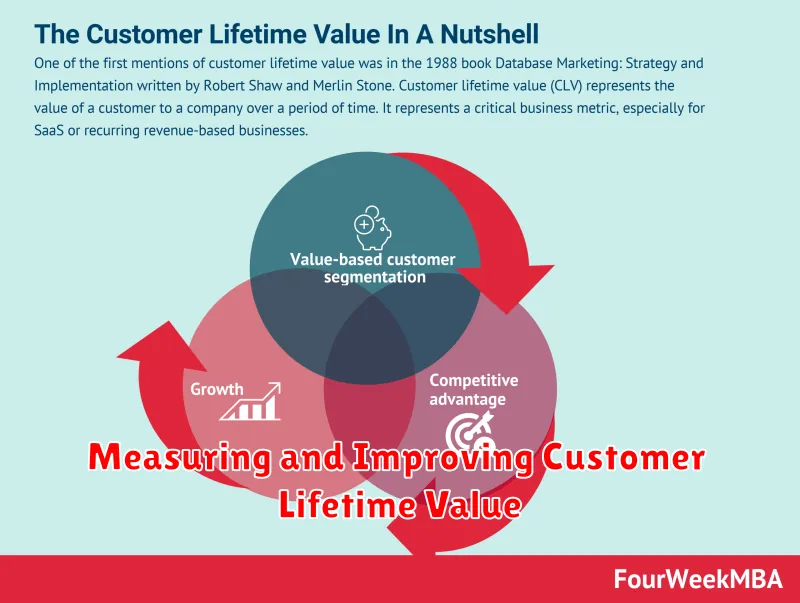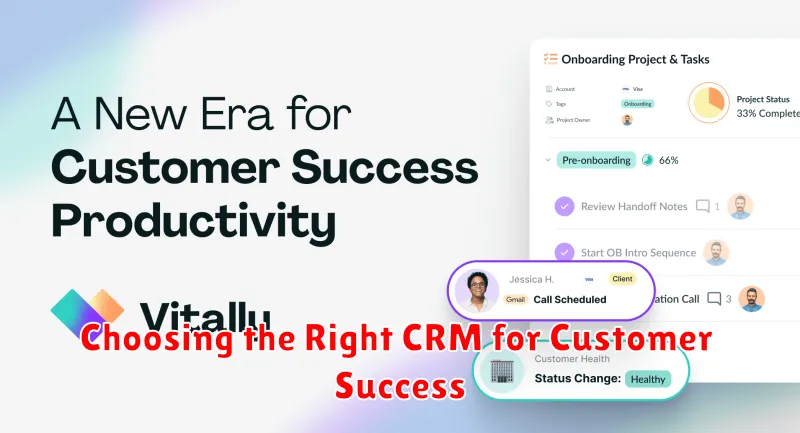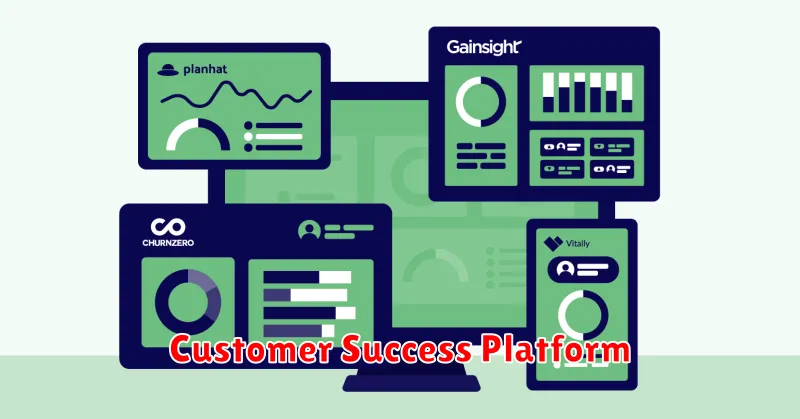Are you looking to take your business to the next level? Customer Relationship Management (CRM) is more than just a buzzword – it’s a powerful tool that can help you achieve your business goals. By implementing a robust CRM system, you can centralize customer data, streamline communication, and ultimately drive customer success. This article will delve into the crucial role of CRM in achieving sustainable growth, highlighting its impact on customer acquisition, retention, and overall business development.
The Role of Customer Success in Business Growth
In today’s competitive business landscape, customer success is no longer a mere afterthought but a crucial driver of sustainable growth. It’s about ensuring that your customers achieve their desired outcomes and realize the full value of your product or service. This approach fosters long-term customer relationships, generates positive word-of-mouth marketing, and ultimately contributes to the overall success of your business.
A well-defined customer success strategy focuses on understanding your customers’ needs, providing them with the necessary resources and support, and actively monitoring their progress. By consistently exceeding customer expectations, you build trust and loyalty, increasing the likelihood of repeat business and referrals.
Key Benefits of Customer Success
- Increased customer retention: Happy and successful customers are more likely to stick around. By actively addressing their needs and challenges, you minimize churn and build lasting relationships.
- Enhanced customer lifetime value (CLTV): When customers are successful with your product or service, they tend to spend more over time, leading to increased CLTV. This translates into greater revenue for your business.
- Improved customer satisfaction: By proactively supporting your customers, you create a positive and empowering experience that leads to higher satisfaction levels. This translates into positive reviews, testimonials, and brand advocacy.
- Stronger brand reputation: A reputation for delivering excellent customer success builds trust and credibility in the market, attracting new customers and solidifying your position as a leader in your industry.
- Accelerated product development: Closely interacting with your customers allows you to gather valuable feedback and insights, which can inform future product development decisions and lead to innovative solutions.
The role of customer success in business growth is undeniable. By prioritizing customer success, you can create a win-win scenario where both your customers and your business thrive. It’s an investment in the future that yields significant returns in terms of revenue, customer loyalty, and brand reputation.
How CRM Supports Customer Success Initiatives
Customer Relationship Management (CRM) software is essential for businesses looking to build strong customer relationships and drive customer success. CRM systems help organizations centralize customer data, track interactions, and provide personalized experiences. By leveraging the power of CRM, businesses can implement effective customer success initiatives that foster loyalty, drive revenue, and enhance overall customer satisfaction.
Understanding Customer Needs
At the core of customer success lies a deep understanding of customer needs. CRM systems provide valuable insights into customer behavior, preferences, and pain points. By analyzing customer data, businesses can identify key areas of focus for their success initiatives. This data-driven approach enables organizations to tailor their strategies and resources to meet specific customer requirements, ensuring a more personalized and impactful customer experience.
Proactive Customer Engagement
Customer success is not a one-time event; it requires ongoing engagement and support. CRM platforms facilitate proactive communication and engagement by providing a centralized platform for managing customer interactions. Businesses can leverage CRM tools to automate personalized outreach, schedule follow-ups, and deliver timely support. By proactively addressing customer needs and providing ongoing value, businesses can build strong relationships that contribute to long-term success.
Streamlined Customer Onboarding
A smooth onboarding experience is crucial for setting the stage for customer success. CRM systems can streamline the onboarding process by providing a central hub for managing customer information, tasks, and communication. By leveraging CRM tools, businesses can ensure that customers are properly guided through the initial stages of their journey, maximizing adoption and value realization. This streamlined approach helps to build trust and set the foundation for a successful customer relationship.
Effective Customer Support
Providing prompt and effective support is essential for customer satisfaction and retention. CRM systems empower support teams to provide personalized assistance, resolve issues efficiently, and build strong relationships with customers. By centralizing customer data and interactions, CRM systems enable support agents to access relevant information, understand customer history, and provide tailored solutions. This data-driven approach enhances support effectiveness and fosters a positive customer experience.
Measuring and Tracking Success
Measuring and tracking customer success metrics is crucial for assessing the effectiveness of initiatives and identifying areas for improvement. CRM systems provide a comprehensive view of customer data and key performance indicators (KPIs), enabling businesses to track progress, identify trends, and make data-driven decisions. By leveraging these insights, organizations can optimize their customer success strategies and ensure continuous improvement.
Conclusion
By embracing CRM technology, businesses can gain a powerful tool for driving customer success. CRM systems facilitate understanding customer needs, proactive engagement, streamlined onboarding, effective support, and data-driven measurement. By leveraging these capabilities, organizations can build strong customer relationships, enhance satisfaction, drive loyalty, and achieve sustainable growth.
Onboarding and Adoption
Onboarding is the process of introducing new users to a product or service. It’s a critical step in the user journey, as it sets the stage for long-term engagement and adoption. A successful onboarding experience helps users understand the value of your product, learn how to use it effectively, and become comfortable with its features.
Adoption, on the other hand, refers to the extent to which users actually use and benefit from your product. It’s a measure of your product’s success, and it’s influenced by a number of factors, including the onboarding experience, product usability, and user satisfaction.
Why are Onboarding and Adoption Important?
Onboarding and adoption are crucial for businesses because they directly impact user engagement, product success, and ultimately, revenue. When users have a positive onboarding experience, they are more likely to:
- Become active users
- Use the product regularly
- Refer other users
- Become brand advocates
Conversely, poor onboarding experiences can lead to user churn, low adoption rates, and negative brand perception. Therefore, it’s essential to invest in creating an onboarding process that is engaging, informative, and user-friendly.
Key Components of Effective Onboarding
A successful onboarding process typically includes the following components:
- Welcome message: A warm welcome message that introduces the product and its core value proposition.
- Product tour: A guided tour that highlights key features and functionalities.
- Interactive tutorials: Engaging tutorials that allow users to practice using the product.
- Personalized recommendations: Tailored content based on user preferences and goals.
- Support and resources: Access to help documentation, FAQs, and support channels.
Best Practices for Onboarding and Adoption
Here are some best practices to ensure successful onboarding and adoption:
- Keep it simple: Avoid overwhelming users with too much information.
- Focus on user value: Show users how your product solves their problems or fulfills their needs.
- Make it interactive: Engage users with interactive elements such as tutorials, quizzes, and games.
- Provide ongoing support: Ensure users have access to resources and assistance when they need it.
- Track key metrics: Monitor metrics such as user engagement, activation rates, and churn to measure the effectiveness of your onboarding process.
By implementing these strategies and continuously refining your onboarding process, you can foster user engagement, increase adoption rates, and ultimately achieve your business goals.
Customer Engagement and Advocacy
In today’s competitive business landscape, it is no longer enough to simply provide good products or services. To truly thrive, businesses need to cultivate strong relationships with their customers. This is where customer engagement and advocacy come into play.
Customer engagement refers to the ongoing interaction and connection that businesses build with their customers. This can be achieved through a variety of channels, such as social media, email marketing, personalized content, and customer support interactions. The goal is to create a positive and memorable experience for customers at every touchpoint.
Customer advocacy is the ultimate goal of engagement. It involves turning satisfied customers into enthusiastic brand ambassadors who actively recommend your products or services to others. This type of word-of-mouth marketing is incredibly powerful, as it comes from a trusted source.
Benefits of Customer Engagement and Advocacy
The benefits of focusing on customer engagement and advocacy are numerous:
- Increased customer loyalty: Engaged customers are more likely to stay loyal to your brand.
- Improved customer retention: Engaged customers are less likely to switch to competitors.
- Higher customer lifetime value: Engaged customers tend to spend more over time.
- Enhanced brand reputation: Positive customer experiences contribute to a strong brand image.
- Increased revenue: Customer advocacy leads to more sales and referrals.
Strategies for Building Customer Engagement and Advocacy
There are many strategies businesses can employ to cultivate customer engagement and advocacy. Here are a few key areas to focus on:
1. Personalized Experiences
Customers appreciate feeling valued and understood. Offer personalized recommendations, targeted content, and customized communications to enhance their experience.
2. Exceptional Customer Support
Provide prompt, helpful, and friendly support that exceeds customer expectations. This builds trust and loyalty.
3. Engaging Content
Create valuable and relevant content that informs, educates, and entertains your audience. This can include blog posts, articles, videos, infographics, and more.
4. Social Media Engagement
Actively engage with customers on social media platforms. Respond to comments, participate in conversations, and run contests to build relationships.
5. Loyalty Programs
Reward loyal customers with points, discounts, exclusive offers, and other perks to show appreciation.
6. Customer Feedback
Solicit and respond to customer feedback to understand their needs and preferences. This helps you improve your products, services, and overall customer experience.
By implementing these strategies and continuously striving to improve the customer experience, businesses can build strong relationships, cultivate brand advocacy, and drive long-term success.
Proactive Support and Issue Resolution
In today’s fast-paced digital landscape, organizations are constantly striving to provide exceptional customer experiences. One crucial aspect of achieving this goal is implementing a proactive approach to support and issue resolution. Proactive support goes beyond simply reacting to customer issues; it involves anticipating potential problems and taking steps to prevent them from occurring in the first place.
By adopting a proactive support strategy, businesses can achieve several key benefits:
- Reduced customer frustration and churn: Proactive support helps prevent issues from escalating and causing major disruptions for customers. When problems are addressed before they become significant, customers are more likely to be satisfied and remain loyal.
- Improved customer satisfaction: Customers appreciate feeling valued and understood. Proactive support demonstrates that an organization cares about their needs and is willing to go the extra mile to ensure their satisfaction.
- Increased productivity and efficiency: By addressing issues before they become critical, proactive support can significantly reduce the workload on support teams. This allows them to focus on more complex tasks and provide a higher level of service.
- Enhanced brand reputation: Proactive support creates a positive impression on customers, leading to improved brand image and loyalty.
Here are some strategies for implementing a proactive support approach:
- Monitor customer feedback: Actively collect and analyze feedback from customers to identify recurring issues or areas for improvement.
- Utilize predictive analytics: Leverage data and analytics to anticipate potential problems and proactively address them.
- Offer self-service options: Provide customers with easy access to knowledge bases, FAQs, and other self-service resources.
- Proactive communication: Keep customers informed about potential issues, upcoming changes, and system updates.
- Regularly review and optimize processes: Continuously evaluate support processes and identify areas for improvement.
By implementing a proactive support approach, organizations can elevate their customer service to a new level, foster strong customer relationships, and drive business growth.
Measuring and Improving Customer Lifetime Value

Customer Lifetime Value (CLTV) is a metric that measures the total revenue a business can expect to generate from a single customer over the entire duration of their relationship. It is a crucial metric for businesses of all sizes, as it provides insights into the long-term value of customers and helps inform strategic decisions related to customer acquisition, retention, and growth.
How to Measure CLTV:
There are several methods for calculating CLTV, but the most common approach involves the following steps:
- Determine the average purchase value: This is the average amount a customer spends on each purchase.
- Calculate the average purchase frequency: This is the average number of purchases a customer makes in a given time period.
- Estimate the average customer lifespan: This is the average length of time a customer remains active with the business.
- Multiply these three figures to get the CLTV: Average Purchase Value x Average Purchase Frequency x Average Customer Lifespan = CLTV
Improving CLTV:
Once you have a good understanding of your CLTV, you can start to implement strategies to improve it. Here are a few key strategies:
- Enhance customer experience: Providing excellent customer service, personalized experiences, and valuable content can increase customer satisfaction and loyalty, leading to longer customer lifespans.
- Implement customer retention programs: Offer loyalty programs, exclusive discounts, and personalized communications to encourage repeat purchases and foster a sense of community.
- Leverage data and analytics: Use data to understand customer behavior, preferences, and needs. This information can help you personalize offers and improve your marketing efforts.
- Expand product or service offerings: Introducing new products or services that address the evolving needs of your customers can create opportunities for increased revenue and customer engagement.
- Develop strong customer relationships: Building trust and rapport with your customers can lead to long-term loyalty and advocacy.
Conclusion:
Measuring and improving CLTV is essential for any business looking to achieve sustainable growth. By understanding the value of your customers and implementing effective strategies to nurture and retain them, you can maximize profitability and build a thriving customer base.
Choosing the Right CRM for Customer Success

In today’s competitive business landscape, customer success is paramount. A robust CRM (Customer Relationship Management) system is no longer a luxury but a necessity for organizations looking to achieve sustainable growth and build lasting customer relationships. With a plethora of CRM solutions available, selecting the right one can be a daunting task. This article will guide you through the key considerations and steps involved in choosing the CRM that best aligns with your customer success goals.
Understanding Your Needs
Before diving into CRM options, it’s crucial to understand your specific needs and requirements. Consider the following questions:
- What are your primary customer success goals?
- What data do you need to track to measure customer success?
- What functionalities are essential for your customer support and onboarding processes?
- What are your budget constraints?
- How many users will be accessing the CRM?
Key Features to Look for
Once you have a clear understanding of your needs, you can start evaluating CRM solutions based on the following key features:
- Customer Segmentation and Targeting: The CRM should allow you to segment your customers based on various criteria and tailor your interactions accordingly.
- Customer Lifecycle Management: The system should provide a comprehensive view of the customer journey, from initial contact to ongoing engagement.
- Sales Automation: Features like lead management, opportunity tracking, and sales forecasting can streamline your sales processes.
- Customer Support and Service: The CRM should facilitate efficient customer support and issue resolution.
- Marketing Automation: Tools for email marketing, social media integration, and campaign management can enhance your marketing efforts.
- Reporting and Analytics: The system should provide insightful reports and dashboards to track key metrics and identify areas for improvement.
Evaluating CRM Options
Once you’ve identified the essential features, it’s time to evaluate different CRM solutions. Here’s a suggested approach:
- Research and Shortlist: Explore popular CRM providers and narrow down your options based on your requirements.
- Free Trials and Demonstrations: Take advantage of free trials and request demonstrations to gain hands-on experience with the CRM interface.
- Read Reviews and Testimonials: Seek feedback from other businesses that have used the CRM solutions you’re considering.
- Compare Pricing and Features: Analyze the pricing plans and ensure they align with your budget and needs.
Implementation and Training
Once you’ve chosen the right CRM, it’s crucial to implement it effectively. This involves:
- Data Migration: Transferring your existing customer data into the new CRM system.
- Configuration and Customization: Setting up workflows, automation rules, and user roles to optimize the CRM for your specific processes.
- User Training: Providing comprehensive training to your team on how to use the CRM effectively.
Conclusion
Choosing the right CRM for customer success is an investment that can yield significant returns. By carefully considering your needs, evaluating CRM options, and implementing the system effectively, you can create a robust foundation for building lasting customer relationships and driving sustainable business growth.
